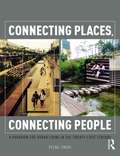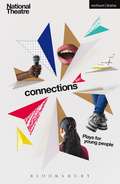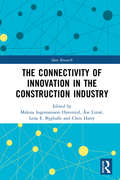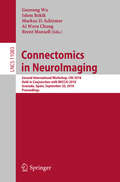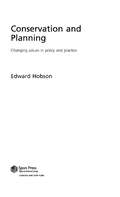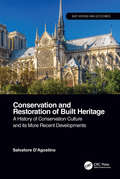- Table View
- List View
Connecting Places, Connecting People: A Paradigm for Urban Living in the 21st Century
by Reena TiwariWhat is a better community? How can we reconfigure places and transport networks to create environmentally friendly, economically sound, and socially just communities? How can we meet the challenges of growing pollution, depleting fossil fuels, rising gasoline prices, traffic congestion, traffic fatalities, increased prevalence of obesity, and lack of social inclusion? The era of car-based planning has led to the disconnection of people and place in developed countries, and is rapidly doing so in the developing countries of the Global South. The unfolding mega-trend in technological innovation, while adding new patterns of future living and mobility in the cities, will question the relevance of face-to-face connections. What will be the ‘glue’ that holds communities together in the future? To build better communities and to build better cities, we need to reconnect people and places. Connecting Places, Connecting People offers a new paradigm for place making by reordering urban planning principles from prioritizing movement of vehicles to focusing on places and the people who live in them. Numerous case studies, including many from developing countries in the Global South, illustrate how this can be realized or fallen short of in practical terms. Importantly, citizens need to be engaged in policy development, to connect with each other and with government agencies. To measure the connectivity attributes of places and the success of strategies to meet the needs, an Audit Tool is offered for a continual quantitative and qualitative evaluation.
Connecting Self-regulated Learning and Performance with Instruction Across High School Content Areas
by Maria K. DiBenedettoThis book shows how principles of self-regulated learning are being implemented in secondary classrooms. The 14 chapters are theoretically driven and supported by empirical research and address all common high school content areas. The book comprises 29 lesson plans in English language arts, natural and physical sciences, social studies, mathematics, foreign language, art, music, health, and physical education. Additionally, the chapters address students with special needs, technology, and homework.Each chapter begins with one or more lesson plans written by master teachers, followed by narratives explaining how the lesson plans were implemented. The chapters conclude with an analysis written by expert researchers of the self-regulated learning elements in the lessons. Each lesson and each analysis incorporate relevant educational standards for that area. Different types of high schools in several states serve as venues.This powerful new book edited by Maria K. DiBenedetto provides a unique and invaluable resource for both secondary teachers and researchers committed to supporting adolescents in the development of academic self-regulation. Each chapter is jointly written by teachers who provide a wealth of materials, including lesson plans, and researchers who situate these lesson plans and academic self-regulation goals within the larger work on self-regulation. The topics covered are far broader than any other book I have seen in terms of developing academic self-regulation, covering over a dozen content areas, including literacy, mathematics, social studies, the sciences, and the arts. Teachers and scholars alike will find this book a must read.Karen Harris, EdD, Arizona State UniversityA practical and magnificent blend of educational research and application. This book goes beyond presenting the findings of research on self regulation by connecting detailed strategies that align with the standards to the research. DiBenedetto et al. clearly illustrate how to develop self regulated learners in the classroom. A refreshing must read for all secondary educators and educational researchers seeking to be well grounded in education research and practical application techniques. Heather Brookman, PhD, Fusion Academy- Park Avenue Self-regulated learning is a research-based process by which teachers help students realize their own role in the learning process. Connecting Self-Regulated Learning and Performance with Instruction Across High School Content Areas consists of model teachers’ lessons and analyses by prominent educational psychologists in the field of self-regulated learning. The book provides teachers with the tools needed to increase students’ awareness of learning and inspires all educators to use self-regulated learning to promote engagement, motivation, and achievement in their students. The book also provides administrators with the principles needed to infuse evidenced based self-regulated learning into their curriculum and instruction. I highly recommend the book!Marty Richburg, Northside High School
Connecting Visual Literacy to Theory: Revisiting the Disruptions of Visual Thinkers in Education and Beyond
by Dana Statton Thompson Ricardo Lopez-LeonThis volume seeks to close the gap between education systems across the world that remain systematically devoted to understanding our world through text rather than images.Through an exploration of the contributions of well- and lesser-known visual thinkers from across disciplines and geographies, the contributors offer contemporary appraisals and modern re-conceptualizations of the subject. The book illuminates how experts from various disciplines ranging from art, communication, education, and philosophy laid the foundations for what we know today as visual literacy. These foundations and innovative ways of thinking and understanding images have been disruptive, but until now, have been relatively understudied. As such, the chapters examine the context of individual thinkers, expanding upon famous theories and providing new insight into why these visual and cognitive processes are imperative to learning and education and to disciplines spanning art history, museum studies, philosophy, photography, and more. The authors, all members of the International Visual Literacy Association (IVLA), are committed to advancing the study of visual literacy by raising new questions and proposing new routes of inquiry. A unique and timely exploration of the way we derive meaning from what we see and how we interact with our visual environment, it will appeal to researchers, scholars, and educators from a range of interdisciplinary backgrounds across art, art education, art history, design, information science, photography, and visual communication.
Connecting Visual Literacy to Theory: Revisiting the Disruptions of Visual Thinkers in Education and Beyond
This volume seeks to close the gap between education systems across the world that remain systematically devoted to understanding our world through text rather than images.Through an exploration of the contributions of well- and lesser-known visual thinkers from across disciplines and geographies, the contributors offer contemporary appraisals and modern re-conceptualizations of the subject. The book illuminates how experts from various disciplines ranging from art, communication, education, and philosophy laid the foundations for what we know today as visual literacy. These foundations and innovative ways of thinking and understanding images have been disruptive, but until now, have been relatively understudied. As such, the chapters examine the context of individual thinkers, expanding upon famous theories and providing new insight into why these visual and cognitive processes are imperative to learning and education and to disciplines spanning art history, museum studies, philosophy, photography, and more. The authors, all members of the International Visual Literacy Association (IVLA), are committed to advancing the study of visual literacy by raising new questions and proposing new routes of inquiry. A unique and timely exploration of the way we derive meaning from what we see and how we interact with our visual environment, it will appeal to researchers, scholars, and educators from a range of interdisciplinary backgrounds across art, art education, art history, design, information science, photography, and visual communication.
Connections: Exploring Contemporary Planning Theory and Practice with Patsy Healey
by Jean Hillier Jonathan MetzgerThe professional practice as well as the academic discipline of planning has been fundamentally re-invented all over the world in recent decades. In this astonishing transition, the thinking and scholarship of Patsy Healey appears as a constantly recurring influence and inspiration around the globe. The purpose of this book is to present, discuss and celebrate Healey’s seminal contributions to the development of the theory and practice of spatial planning. The volume contains a selection of 13 less readily available, but nevertheless, key texts by Healey, which have been selected to represent the trajectory of Patsy’s work across the several decades of her research career. 12 original chapters by a wide range of invited contributors take the ideas in the reprinted papers as points of departure for their own work, tracing out their continuing relevance for contemporary and future directions in planning scholarship. In doing so, these chapters tease out the themes and interests in Healey’s work which are still highly relevant to the planning project. The title - Connections - symbolises relationality, possibly the most outstanding element linking Patsy’s ideas. The book showcases the wide international influence of Patsy’s work and celebrates the whole trajectory of work to show how many of her ideas on for instance the role of theory in planning, processes of change, networking as a mode of governance, how ideas spread, and ways of thinking planning democratically were ahead of their time and are still of importance.
Connections: Exploring Contemporary Planning Theory and Practice with Patsy Healey (Deleuze Connections Eup Ser.)
by Jean Hillier Jonathan MetzgerThe professional practice as well as the academic discipline of planning has been fundamentally re-invented all over the world in recent decades. In this astonishing transition, the thinking and scholarship of Patsy Healey appears as a constantly recurring influence and inspiration around the globe. The purpose of this book is to present, discuss and celebrate Healey’s seminal contributions to the development of the theory and practice of spatial planning. The volume contains a selection of 13 less readily available, but nevertheless, key texts by Healey, which have been selected to represent the trajectory of Patsy’s work across the several decades of her research career. 12 original chapters by a wide range of invited contributors take the ideas in the reprinted papers as points of departure for their own work, tracing out their continuing relevance for contemporary and future directions in planning scholarship. In doing so, these chapters tease out the themes and interests in Healey’s work which are still highly relevant to the planning project. The title - Connections - symbolises relationality, possibly the most outstanding element linking Patsy’s ideas. The book showcases the wide international influence of Patsy’s work and celebrates the whole trajectory of work to show how many of her ideas on for instance the role of theory in planning, processes of change, networking as a mode of governance, how ideas spread, and ways of thinking planning democratically were ahead of their time and are still of importance.
Connections 500: Blackout; Eclipse; What Are They Like?; Bassett; I'm Spilling My Heart Out Here; Gargantua; Children of Killers; Take Away; It Snows; The Musicians; Citizenship; Bedbug
by Snoo Wilson Simon Armitage Jackie Kay Patrick Marber Mark Ravenhill Bryony Lavery Frantic Assembly Davey Anderson James Graham Katori Hall Carl Grose Stacey Gregg Lucinda Coxon Rufus NorrisDrawing together the work of 12 leading playwrights, this National Theatre Connections anthology celebrates highlights from 21 years of the Connections festival with a retrospective selection of plays. Featuring work by some of the most prolific playwrights of the 20th and 21st centuries, and together in one volume, the anthology offers young performers between the ages of 13 and 19 an engaging selection of plays to perform, read or study.Each play has been specifically commissioned by the National Theatre's literary department over the years, with the young performer in mind. In 2016, these plays were then performed by approximately 500 schools and youth theatre companies across the UK and Ireland, in partnership with multiple professional partner regional theatres at which the works were showcased. The anthology contains all 12 of the play scripts; notes from the writer and director of each play, addressing the themes and ideas behind the play; and production notes and exercises for the drama groups.This year's anniversary anthology includes plays by Snoo Wilson, Gary Kemp and Guy Pratt; Simon Armitage; Jackie Kay; Patrick Marber; Mark Ravenhill; Bryony Lavery & Frantic Assembly; Davey Anderson; James Graham; Katori Hall; Carl Grose; Stacey Gregg; and Lucinda Coxon.
Connections 500: Blackout; Eclipse; What Are They Like?; Bassett; I'm Spilling My Heart Out Here; Gargantua; Children of Killers; Take Away; It Snows; The Musicians; Citizenship; Bedbug
by Snoo Wilson Simon Armitage Jackie Kay Patrick Marber Mark Ravenhill Bryony Lavery Frantic Assembly Davey Anderson James Graham Katori Hall Carl Grose Stacey Gregg Lucinda Coxon Rufus NorrisDrawing together the work of 12 leading playwrights, this National Theatre Connections anthology celebrates highlights from 21 years of the Connections festival with a retrospective selection of plays. Featuring work by some of the most prolific playwrights of the 20th and 21st centuries, and together in one volume, the anthology offers young performers between the ages of 13 and 19 an engaging selection of plays to perform, read or study.Each play has been specifically commissioned by the National Theatre's literary department over the years, with the young performer in mind. In 2016, these plays were then performed by approximately 500 schools and youth theatre companies across the UK and Ireland, in partnership with multiple professional partner regional theatres at which the works were showcased. The anthology contains all 12 of the play scripts; notes from the writer and director of each play, addressing the themes and ideas behind the play; and production notes and exercises for the drama groups.This year's anniversary anthology includes plays by Snoo Wilson, Gary Kemp and Guy Pratt; Simon Armitage; Jackie Kay; Patrick Marber; Mark Ravenhill; Bryony Lavery & Frantic Assembly; Davey Anderson; James Graham; Katori Hall; Carl Grose; Stacey Gregg; and Lucinda Coxon.
The Connectivity of Innovation in the Construction Industry (Spon Research)
by Chris Harty Malena Ingemansson Havenvid Åse Linné Lena E. BygballeThe construction industry is currently experiencing accelerating developments concerning societal demands along with project complexity, internationalization and digitalization. In an attempt to grasp the consequences of these demands on productivity and innovation, this edited book addresses how innovation is likely to take place with a more long-term perspective on the construction sector. While existing literature focuses on organizational discontinuity and fragmentation as the main reasons for the apparent lack of innovation in the industry, this book highlights the connectivity of construction actors, resources and activities as fundamental for understanding how innovation takes place.Through 15 empirically grounded chapters, the book shows how innovation is part of construction processes on various levels, including project, firm and industry, and that these innovation processes are characterized by organizational and technological connectivity over time. Written by European business management scholars, the chapters cover empirical cases and examples from both a multi-organizational and a multi-international perspective in terms of covering the viewpoints of different industry actors and the contexts of several different European countries including: Sweden, Norway, the UK, Italy, France, Hungary and Poland. By illustrating how connectivity is part of innovation processes in the creation of single-product innovations, of various innovations within and across projects, as well as a fundamental aspect of the processes in which innovations cross nations, the book provides a new angle on how to understand construction innovation and where the industry might (or needs to) be heading next. This book is essential reading for anyone interested in construction management, project management, engineering management, innovation studies, business and management studies.
The Connectivity of Innovation in the Construction Industry (Spon Research)
by Chris Harty Malena Ingemansson Havenvid Åse Linné Lena E. BygballeThe construction industry is currently experiencing accelerating developments concerning societal demands along with project complexity, internationalization and digitalization. In an attempt to grasp the consequences of these demands on productivity and innovation, this edited book addresses how innovation is likely to take place with a more long-term perspective on the construction sector. While existing literature focuses on organizational discontinuity and fragmentation as the main reasons for the apparent lack of innovation in the industry, this book highlights the connectivity of construction actors, resources and activities as fundamental for understanding how innovation takes place.Through 15 empirically grounded chapters, the book shows how innovation is part of construction processes on various levels, including project, firm and industry, and that these innovation processes are characterized by organizational and technological connectivity over time. Written by European business management scholars, the chapters cover empirical cases and examples from both a multi-organizational and a multi-international perspective in terms of covering the viewpoints of different industry actors and the contexts of several different European countries including: Sweden, Norway, the UK, Italy, France, Hungary and Poland. By illustrating how connectivity is part of innovation processes in the creation of single-product innovations, of various innovations within and across projects, as well as a fundamental aspect of the processes in which innovations cross nations, the book provides a new angle on how to understand construction innovation and where the industry might (or needs to) be heading next. This book is essential reading for anyone interested in construction management, project management, engineering management, innovation studies, business and management studies.
Connectomics in NeuroImaging: First International Workshop, Cni 2017, Held In Conjunction With Miccai 2017, Quebec City, Qc, Canada, September 14, 2017, Proceedings (Lecture Notes in Computer Science #10511)
by Brent Munsell Ai Wern Chung Markus D. Schirmer Islem Rekik Guorong WuThis book constitutes the refereed proceedings of the Second International Workshop on Connectomics in NeuroImaging, CNI 2018, held in conjunction with MICCAI 2018 in Granada, Spain, in September 2018. The 15 full papers presented were carefully reviewed and selected from 20 submissions. The papers deal with new advancements in network construction, analysis, and visualization techniques in connectomics and their use in clinical diagnosis and group comparison studies as well as in various neuroimaging applications.
Connectomics in NeuroImaging: First International Workshop, CNI 2017, Held in Conjunction with MICCAI 2017, Quebec City, QC, Canada, September 14, 2017, Proceedings (Lecture Notes in Computer Science #10511)
by Guorong Wu Paul Laurienti Leonardo Bonilha Brent C. MunsellThis book constitutes the refereed proceedings of the First International Workshop on Connectomics in NeuroImaging, CNI 2017, held in conjunction with MICCAI 2017 in Quebec City, Canada, in September 2017. The 19 full papers presented were carefully reviewed and selected from 26 submissions. The papers deal with new advancements in network construction, analysis, and visualization techniques in connectomics and their use in clinical diagnosis and group comparison studies as well as in various neuroimaging applications.
Connoisseurship
by Christina M. Anderson and Peter StewartDespite the central importance of connoisseurship in the rarefied world of art collecting, it occupies an uncomfortable position in modern scholarship. On the one hand, the concept retains a significant role in the study of art and the care of public and private collections when it is linked with art appreciation, qualities visible to the attuned eye, or the processes of attribution and authentication. On the other hand, the last century has seen connoisseurship marginalized in academic discourse: it is often associated with amateurism, social elitism, status-display, and intellectual mystification. The present collection of essays enters this breach and--by adopting a broad, interdisciplinary approach--considers connoisseurship afresh, investigating its practice in both familiar and unexpected places. Essays on the role of connoisseurship in Western art history appear alongside innovative, global perspectives on Chinese numismatics and walnut collecting, wine and coffee expertise, the market for geological specimens, and the parallels between Morellian connoisseurship and modern forensics. These essays resonate with one another in surprising ways and create new dialogues about connoisseurship's meaning and application, demonstrating that its practice can be both intuitive and scientific.
Connoisseurship
Despite the central importance of connoisseurship in the rarefied world of art collecting, it occupies an uncomfortable position in modern scholarship. On the one hand, the concept retains a significant role in the study of art and the care of public and private collections when it is linked with art appreciation, qualities visible to the attuned eye, or the processes of attribution and authentication. On the other hand, the last century has seen connoisseurship marginalized in academic discourse: it is often associated with amateurism, social elitism, status-display, and intellectual mystification. The present collection of essays enters this breach and--by adopting a broad, interdisciplinary approach--considers connoisseurship afresh, investigating its practice in both familiar and unexpected places. Essays on the role of connoisseurship in Western art history appear alongside innovative, global perspectives on Chinese numismatics and walnut collecting, wine and coffee expertise, the market for geological specimens, and the parallels between Morellian connoisseurship and modern forensics. These essays resonate with one another in surprising ways and create new dialogues about connoisseurship's meaning and application, demonstrating that its practice can be both intuitive and scientific.
Consensus Design
by Rosie Parnell Christopher DayConsensus Design offers a practical step by step guide to co-design; an increasingly important consideration for architects as they compete for work.The text moves from identifying the methodology of the process to developing a series of principles and practical steps which illustrate how consensus design can be established. For easy reference, flow charts show the process of achieving consensus design and include variations for different types of project and different groups of people. It gives clear timings so that agreements can be reached within a specific time frame, and also features a number of case studies to illustrate consensus design principles in practice. Case studies include projects in the UK, US, and Sweden.Consensus design isn't just a utopian ideal. It's the only meaningful way in which people can be involved in shaping where they live and work. It can have an influence on social stability, crime-reduction, personal health and building longevity, all of which in turn have monetary and environmental cost implications. Its consideration can also greatly help architects win work and commissions.Day argues that when places are designed by professionals for people, many things obvious to the residents are overlooked. When they are designed by lay people, the design can suffer from the lowest common denominator factor. When places are designed by both it tends to end up in conflict. However, Consensus Design shows that co-design is not doomed to either conflict or banality if it is managed correctly.
Consensus Design
by Rosie Parnell Christopher DayConsensus Design offers a practical step by step guide to co-design; an increasingly important consideration for architects as they compete for work.The text moves from identifying the methodology of the process to developing a series of principles and practical steps which illustrate how consensus design can be established. For easy reference, flow charts show the process of achieving consensus design and include variations for different types of project and different groups of people. It gives clear timings so that agreements can be reached within a specific time frame, and also features a number of case studies to illustrate consensus design principles in practice. Case studies include projects in the UK, US, and Sweden.Consensus design isn't just a utopian ideal. It's the only meaningful way in which people can be involved in shaping where they live and work. It can have an influence on social stability, crime-reduction, personal health and building longevity, all of which in turn have monetary and environmental cost implications. Its consideration can also greatly help architects win work and commissions.Day argues that when places are designed by professionals for people, many things obvious to the residents are overlooked. When they are designed by lay people, the design can suffer from the lowest common denominator factor. When places are designed by both it tends to end up in conflict. However, Consensus Design shows that co-design is not doomed to either conflict or banality if it is managed correctly.
Consent in Shakespeare: What Women Do and Don’t Say and Do in Shakespeare’s Mediterranean Comedies and Origin Stories (Studies in Performance and Early Modern Drama)
by Artemis PreeshlBy examining how female characters speak and act during coming of age, engagement, marriage, and intimacy, Consent in Shakespeare will enhance understanding about how and why women spoke, remained silent, or acted as they did in relation to their intimate partners in Early Modern and contemporary private and public situations in and around the Mediterranean. Consent in intimate relationships is front and center in today’s conversations. This book re-examines the verbal and physical interactions of female-identified characters in Early Modern and contemporary cultures in Shakespeare’s Mediterranean comedies and the sources from which he derived his plays. This re-examination of the words that women say or do not say, and actions that women do or do not take, in Shakespeare’s Mediterranean plays and his probable sources sheds light on how Shakespeare’s audiences might have perceived Mediterranean cultural mores and norms. Assessment of source materials for Shakespeare’s comedies set in the Balkans, France, Italy, the Near East, North Africa, and Spain suggests how women of diverse backgrounds communicated in everyday life and peak life experiences in the Early Modern era. Given Shakespeare’s impact worldwide, this initiative to shift the conversation about the power of consent of female protagonists and supporting characters in Shakespeare’s Mediterranean plays will further transform conversations about consent in class, board and conference rooms, and the international stage.
Consent in Shakespeare: What Women Do and Don’t Say and Do in Shakespeare’s Mediterranean Comedies and Origin Stories (Studies in Performance and Early Modern Drama)
by Artemis PreeshlBy examining how female characters speak and act during coming of age, engagement, marriage, and intimacy, Consent in Shakespeare will enhance understanding about how and why women spoke, remained silent, or acted as they did in relation to their intimate partners in Early Modern and contemporary private and public situations in and around the Mediterranean. Consent in intimate relationships is front and center in today’s conversations. This book re-examines the verbal and physical interactions of female-identified characters in Early Modern and contemporary cultures in Shakespeare’s Mediterranean comedies and the sources from which he derived his plays. This re-examination of the words that women say or do not say, and actions that women do or do not take, in Shakespeare’s Mediterranean plays and his probable sources sheds light on how Shakespeare’s audiences might have perceived Mediterranean cultural mores and norms. Assessment of source materials for Shakespeare’s comedies set in the Balkans, France, Italy, the Near East, North Africa, and Spain suggests how women of diverse backgrounds communicated in everyday life and peak life experiences in the Early Modern era. Given Shakespeare’s impact worldwide, this initiative to shift the conversation about the power of consent of female protagonists and supporting characters in Shakespeare’s Mediterranean plays will further transform conversations about consent in class, board and conference rooms, and the international stage.
Conservation: RIBA Plan of Work 2013 Guide
by Hugh FeildenConservation is part of a brand new series providing must-read practical guidance to running efficient and successful projects using the new RIBA Plan of Work 2013. Each guide takes a particular angle – in this case the author guides you through working on a conservation project - and explains the essential activities required at each stage. Concise and easy to use with a consistent format these guides provide the ultimate quick reference support at your desk or on-site. This is an authoritative ‘how to’ full of pragmatic advice, examples and in-text features such as ‘hints and tips’ that illuminate best practice and clever solutions. Designed to be used on all projects – large and small – and across all types of procurement, they are task rather than role-oriented acknowledging that a variety of people take on these responsibilities. They are also invaluable for architectural students at Part 3 who are getting to grips with the realities of practice.
Conservation: RIBA Plan of Work 2013 Guide
by Hugh FeildenConservation is part of a brand new series providing must-read practical guidance to running efficient and successful projects using the new RIBA Plan of Work 2013. Each guide takes a particular angle – in this case the author guides you through working on a conservation project - and explains the essential activities required at each stage. Concise and easy to use with a consistent format these guides provide the ultimate quick reference support at your desk or on-site. This is an authoritative ‘how to’ full of pragmatic advice, examples and in-text features such as ‘hints and tips’ that illuminate best practice and clever solutions. Designed to be used on all projects – large and small – and across all types of procurement, they are task rather than role-oriented acknowledging that a variety of people take on these responsibilities. They are also invaluable for architectural students at Part 3 who are getting to grips with the realities of practice.
Conservation
by Alison Richmond Alison Bracker'Conservation: Principles, Dilemmas, and Uncomfortable Truths' presents multi-perspective critical analyses of the ethics and principles that guide the conservation of works of art and design, archaeological artefacts, buildings, monuments, and heritage sites on behalf of society. Contributors from the fields of philosophy, sociology, history, art and design history, museology, conservation, architecture, and planning and public policy address a wide range of conservation principles, practices, and theories from the US, Canada, Europe, Australia and New Zealand, encouraging the reader to make comparisons across subjects and disciplines. By wrestling with and offering ways of disentangling the ethical dilemmas confronting those who maintain and sustain cultural heritage for today and tomorrow, 'Conservation: Principles, Dilemmas, and Uncomfortable Truths' provides an essential reference text for conservation professionals, museum and heritage professionals, art and cultural historians, lecturers and students, and all others invested in cultural heritage theories and practices. Alison Richmond, as a Senior Conservator in the Victoria and Albert Museum and Deputy Head of the Conservation Department at the Royal College of Art, maintains teaching and research roles in conservation theory, principles and ethics, and has developed decision-making tools for conservators. She is an Accredited Conservator-Restorer (ACR), a Fellow of the International Institute for Conservation (FIIC), and a Trustee of the UK’s Institute of Conservation (Icon) since 2005. Alison Bracker received her PhD in the History of Art from the University of Leeds, and manages the Events & Lectures programme at the Royal Academy of Arts in London. As co-founder of Bracker Fiske Consultants, she advises on the presentation, description, documentation, and care of artworks comprising modern media, and lectures and publishes widely on the theoretical and practical issues arising from the conservation of non-traditional and impermanent materials in contemporary works of art.
Conservation
by Alison Richmond Alison Bracker'Conservation: Principles, Dilemmas, and Uncomfortable Truths' presents multi-perspective critical analyses of the ethics and principles that guide the conservation of works of art and design, archaeological artefacts, buildings, monuments, and heritage sites on behalf of society. Contributors from the fields of philosophy, sociology, history, art and design history, museology, conservation, architecture, and planning and public policy address a wide range of conservation principles, practices, and theories from the US, Canada, Europe, Australia and New Zealand, encouraging the reader to make comparisons across subjects and disciplines. By wrestling with and offering ways of disentangling the ethical dilemmas confronting those who maintain and sustain cultural heritage for today and tomorrow, 'Conservation: Principles, Dilemmas, and Uncomfortable Truths' provides an essential reference text for conservation professionals, museum and heritage professionals, art and cultural historians, lecturers and students, and all others invested in cultural heritage theories and practices. Alison Richmond, as a Senior Conservator in the Victoria and Albert Museum and Deputy Head of the Conservation Department at the Royal College of Art, maintains teaching and research roles in conservation theory, principles and ethics, and has developed decision-making tools for conservators. She is an Accredited Conservator-Restorer (ACR), a Fellow of the International Institute for Conservation (FIIC), and a Trustee of the UK’s Institute of Conservation (Icon) since 2005. Alison Bracker received her PhD in the History of Art from the University of Leeds, and manages the Events & Lectures programme at the Royal Academy of Arts in London. As co-founder of Bracker Fiske Consultants, she advises on the presentation, description, documentation, and care of artworks comprising modern media, and lectures and publishes widely on the theoretical and practical issues arising from the conservation of non-traditional and impermanent materials in contemporary works of art.
Conservation and Planning: Changing Values in Policy and Practice
by Edward HobsonConserving historic buildings continues to excite and inflame opinion. The means of protecting such buildings and areas are well established but frequently suffer a lack of wider understanding. Conservation and Planning takes a detailed look at the way these processes have evolved and their use today by policy makers and local decision makers.This book presents original research into how national and local decision-makers construct and implement conservation of the built environment. The findings in this book challenge many of the assumptions supporting conservation.
Conservation and Planning: Changing Values in Policy and Practice
by Edward HobsonConserving historic buildings continues to excite and inflame opinion. The means of protecting such buildings and areas are well established but frequently suffer a lack of wider understanding. Conservation and Planning takes a detailed look at the way these processes have evolved and their use today by policy makers and local decision makers.This book presents original research into how national and local decision-makers construct and implement conservation of the built environment. The findings in this book challenge many of the assumptions supporting conservation.
Conservation and Restoration of Built Heritage: A History of Conservation Culture and its More Recent Developments (Built Heritage and Geotechnics)
by Salvatore D'AgostinoThe word conservation, when used in the context of the preservation of built heritage, implies an intrinsically complex concept that evolved over time, since it has been influenced by the perception of history throughout time. This volume emphasises why an understanding of the cultural evolution of the conservation approach must be considered a prerequisite for architects and engineers if they are to cooperate in full harmony with historic-artistic culture for the preservation of global built heritage. In particular, the volume highlights how, during the second half of the last century, the preservation process also involved engineering – the science of making practical applications of knowledge – which, for a long time, made an uncritical use of techniques and materials and devised interventions on historical heritage that were heavily invasive. The volume also devotes special attention to the problems related to seismic risk, to which Italy, Greece and Portugal are particularly prone. Problems that emerge during the crisis and reconstruction phases are dealt with in detail, as is scheduled maintenance, as this latter approach always constitutes an improvement in the performance of the monument and is the most appropriate tool for the conservation of the built heritage. Finally, the volume collects examples of building restoration with case studies of many outstanding monuments. The work will appeal to professionals and academics in the broader fields of civil engineering (both geotechnical and structural engineering), architecture, art history, the history of architecture, restoration and cultural heritage management. This book will: Provide a critical reading of the history of conservation; Discuss materials and techniques of ancient architecture; Cover seismic vulnerability and preservation of the historic integrity of the monument; Advocate an approach based on programmed maintenance; Feature numerous case histories, including St Mark’s Basilica in Venice and the complex restoration of the cathedral of Notre-Dame in Paris.
